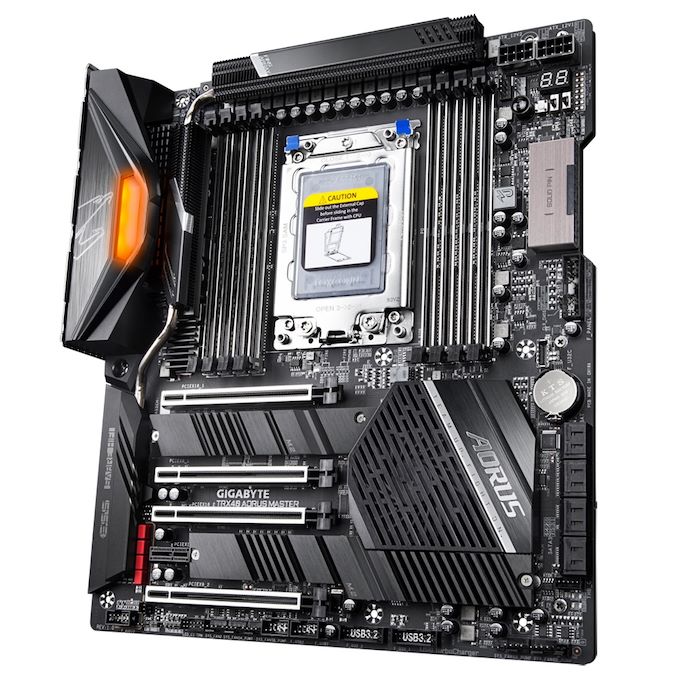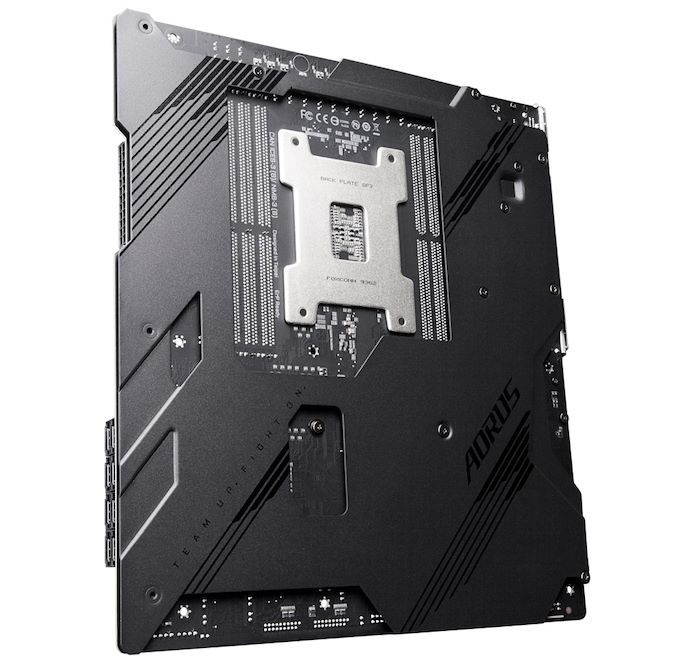The AMD TRX40 Motherboard Overview: 12 New Motherboards Analyzed
by Gavin Bonshor on November 28, 2019 9:00 AM EST- Posted in
- Motherboards
- AMD
- MSI
- Gigabyte
- ASRock
- Asus
- TRX40
- Threadripper 3000
- Castle Peak
GIGABYTE TRX40 Aorus Master
The GIGABYTE TRX40 Aorus Master sits below the TRX40 Aorus Xtreme in the product stack and combines a similar style, in a slightly smaller, but still larger than normal E-ATX PCB. Still retaining the high-end feel, the TRX40 Master is using an E-ATX PCB which is crammed with good quality controllers. The most notable features include support for DDR4-4400 and 256 GB, a pair of Ethernet ports on the rear panel including an Aquantia 5 G controller, Intel's AX200 Wi-Fi 6 wireless interface, and a beefy 16-phase CPU power delivery.
Starting from the top, the GIGABYTE TRX40 Aorus Master has eight memory slots in two banks of four on either side of the sTRX4 socket with support for DDR4-4400 and up to 256 GB in total. Taking a slightly more basic approach to the aesthetics, the rear panel cover does include integrated RGB LEDs, with black heatsinks on a black PCB. The large black aluminium power delivery heatsinks which are interconnected via a heat pipe are cooling a 16-phase power which consists of an Infineon XDPE132G5C 16-phase PWM controller, with sixteen Infineon TDA21472 70 A power stages. Providing power to the CPU is two 8-pin 12 V ATX power connectors which are located in the top right-hand corner.
Also at the top right-hand corner of the board is a two-digit LED debug, while below this is a right-angled 24-pin motherboard power connector. For PCIe devices, there are four full-length PCIe 4.0 slots which operate at x16/x8/x16+x8 and a single PCIe 4.0 x1 slot. The TRX40 chipset heatsink is actively cooled just as we saw with X570. For storage, the GIGABYTE TRX40 Aorus Master has three PCIe 4.0 x4 M.2 slots which include M.2 heatsinks for each slot, and there are eight SATA ports with support for RAID 0, 1, and 10 arrays.
Like with the GIGABYTE TRX40 Aorus Xtreme, the TRX40 Aorus Master also includes a large black metal backplate which will add extra weight to the board. The backplate displays the motto 'Team Up, Fight On' which is more of a gaming term, which is understandable given the boards Aorus branding. The TRX40 Aorus Master includes dual BIOS with a switch which allows users to select between the two, and for cooling, there is a total of eight 4-pin headers. These are split into one for a CPU fan, one dedicated for a water pump, and six for chassis fans.
On the rear panel are five USB 3.1 G2 Type-A, one USB 3.1 G2 Type-C, and two USB 2.0 ports. There are two Ethernet ports with one controlled by an Aquantia 5 G, and the other by an Intel Gigabit Ethernet controller. This model also includes Intel's AX200 Wi-Fi 6 wireless interface and also adds BT 5.0 connectivity too. To the left-hand side is a Clear CMOS and Q-Flash Plus switch, with the five 3.5 mm audio jacks and S/PDIF optical output handled by a Realtek ALC4050H and Realtek ALC1220 audio codec pairing. The TRX40 Aorus Master also includes a Realtek ALC4050H and ESS Sabre 9218 DAC for the front panel audio.
The GIGABYTE TRX40 Aorus Master is still a high-end TRX40 motherboard and with an MSRP of $499, it isn't exactly cheap, but it does offer users plenty of good quality features on AMD's new HEDT platform. While the Aorus brand is mainly targeted at gamers, the TRX40 Aorus Master looks to combine elements from both the enthusiast and gaming sides, to create a reasonably priced multi-purpose model for all looking to use and unlock all of the power within the Threadripper 3000 processors.













109 Comments
View All Comments
gavbon - Thursday, November 28, 2019 - link
We tested the 3970X and 3960X in our review (https://www.anandtech.com/show/15044/the-amd-ryzen...In the power testing, our chips hit 280w without issues, especially the 32-core. Which the definition of TDP is up for question, the CPUs seem bang on the power figures we saw
Hul8 - Thursday, November 28, 2019 - link
At least one reviewer got ~285 - 295 W power consumption testing Threadripper 3rd at stock, until they realized they had memory overclocked to 3600 MT/s.With the RAM also at stock (3200 MT/s), the power consumption ended up between 279 - 280 W, so just within the given TDP.
tamalero - Saturday, November 30, 2019 - link
Also, doesn't some motherboards (Particularly ASUS and Gigabyte) do minimal overclock by default on the "recommended settings" ?eek2121 - Friday, November 29, 2019 - link
TDP != power consumed. TDP is thermal design power. The type of cooler itself can change the TDP formula in some cases (due to being part of the formula), and AMD, NVIDIA, and Intel all have different ways of calculating TDP.eastcoast_pete - Thursday, November 28, 2019 - link
Thanks Gavin, interesting article. Question: Your initial mentioning of the chipset says it's made on GloFo's 12 nm node, but it's 14 nm a bit later in the article. Can you clarify? Thanks!jeremyshaw - Friday, November 29, 2019 - link
Since the last page has a picture of the chipset saying Made in Taiwan, it's probably either TSMC or UMC... unless if packaging somehow counts as "made in."msroadkill612 - Friday, November 29, 2019 - link
Good spotting & there may be more to t than u think.Dunno, but others may?
I recall reading that the exciting new IO chip on Zen 2, & the TR chipset, are ~"cut an pastes" of each other - one is made by tsmc & the other by glofo.
This may be the source of the confusion?
Bccc1 - Thursday, November 28, 2019 - link
Thanks for this writeup. I'm currently drawn to Gigabytes TRX40 Designare and TRX40 Aorus Xtreme. Does the "40GB/s GC-Titan Ridge add-in card" work on any board?Any info on bifurcation support? Gigabyte is quite clear about that and offers x4x4x4x4 for the x16 slots and x4x4 for the x8 slots. Sadly no 8x4x4 or x8x8. MSIs manual explains the BIOS option "PCIe SlotX Lanes Configuration" with the sentence "PCIe lanes configuration for MSI M.2 XPANDER series cards/ Other M.2 PCIe
storage card." which sounds like x4x4x4x4 bifurcation to me, but is quite vague.
Is x8x8 and x8x4x4 supported on any board?
msroadkill612 - Friday, November 29, 2019 - link
Bifurcation obfuscation?eek2121 - Friday, November 29, 2019 - link
I can't speak to the current MSI offerings, but my x399 Gaming Carbon (off the top of my head, I don't use this feature, however) supports x4x4x4x4 and x8x8. Other modes may be possible, but I haven't looked.